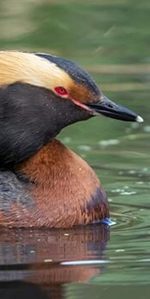| Horned Grebe | ||
 |
Classification(s) : | Prey |
| Cat Name : | Duck | |
| Common Name : | Horned Grebe | |
| Scientific Name : | Podiceps auritus | |
| Other Name(s) : | Slavonian Grebe, Devil-diver, Hell-diver, Pink-Eyed Diver, Water Witch | |
| Physical Description : | During summer the Horned Grebe is a waterbird with a black head and brown ear tufts on either sides of it’s head. Their wings and back are black, and the body is ruddy colored. They have a white underside. The head and front of the neck are white, and the underside is gray. |
|
| Physical Statistics : | Length: 12 – 15 Inches (31 – 38 Centimeters) |
|
| Behavior : | Horned Grebes live in ponds and rivers. They nest float, and they are active during the day. They dive from the surface to get their food. Young Horned Grebes stay on their mother’s back. Horned Grebes migrate south during the winter and are not seen in the forest then. They are in the forest for their migrations and the summer breeding season. |
|
| Social Organization : | Flock; |
|
| Approval Level : | Mod; Horned Grebes are typically seen during their migrations, and rarely breed in the forest due to the lack of their favored territories. | |
| Kill Difficulty : | Moderate; Horned Grebes are large and can deliver solid blows with their wings. |
|
| Training Level : | Specialty - Duck; A hunter must wait for the Horned Grebe to come close to land where they can be ambushed. |
|
| Hunting Tactic : | Waterfowl | |
| Food Quality : | High; Horned Grebes are large enough to be shared between many cats. | |
